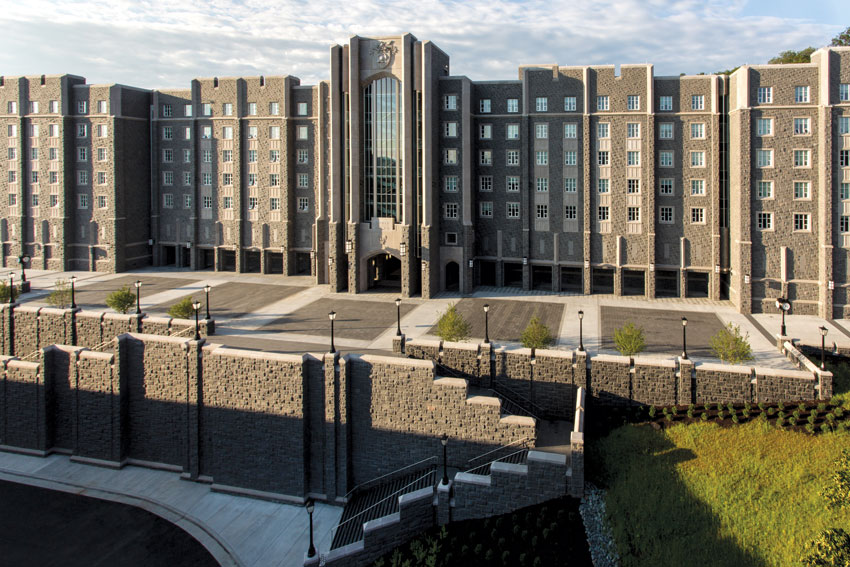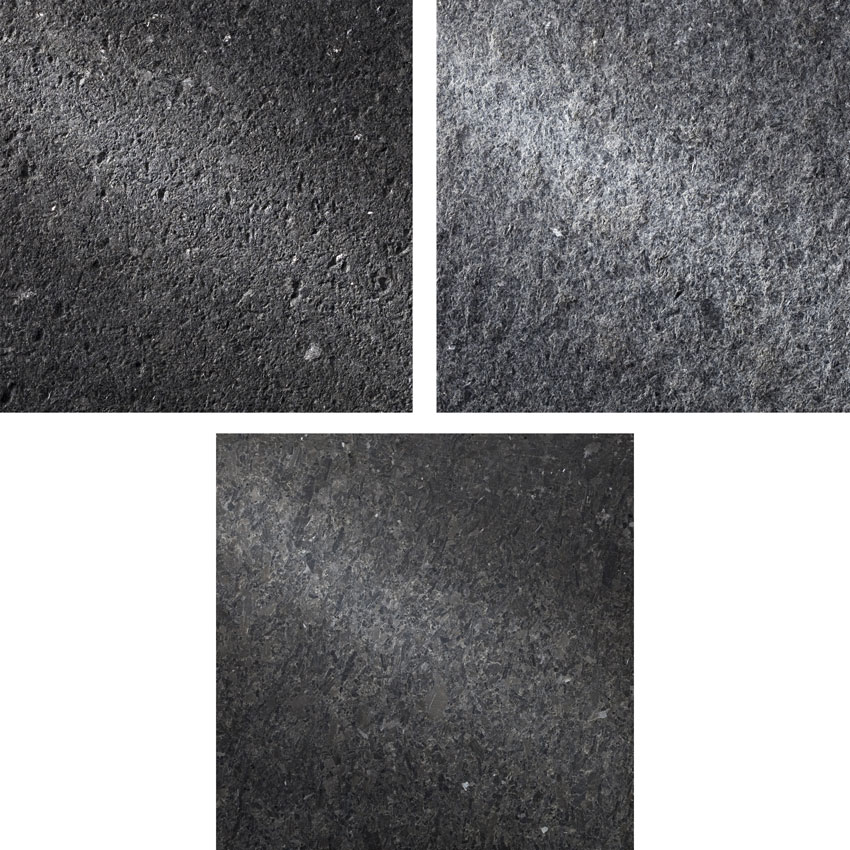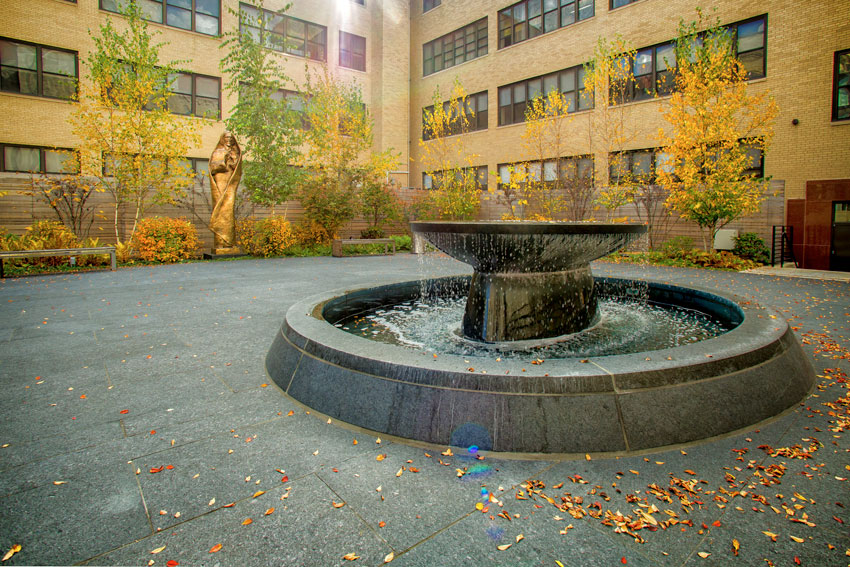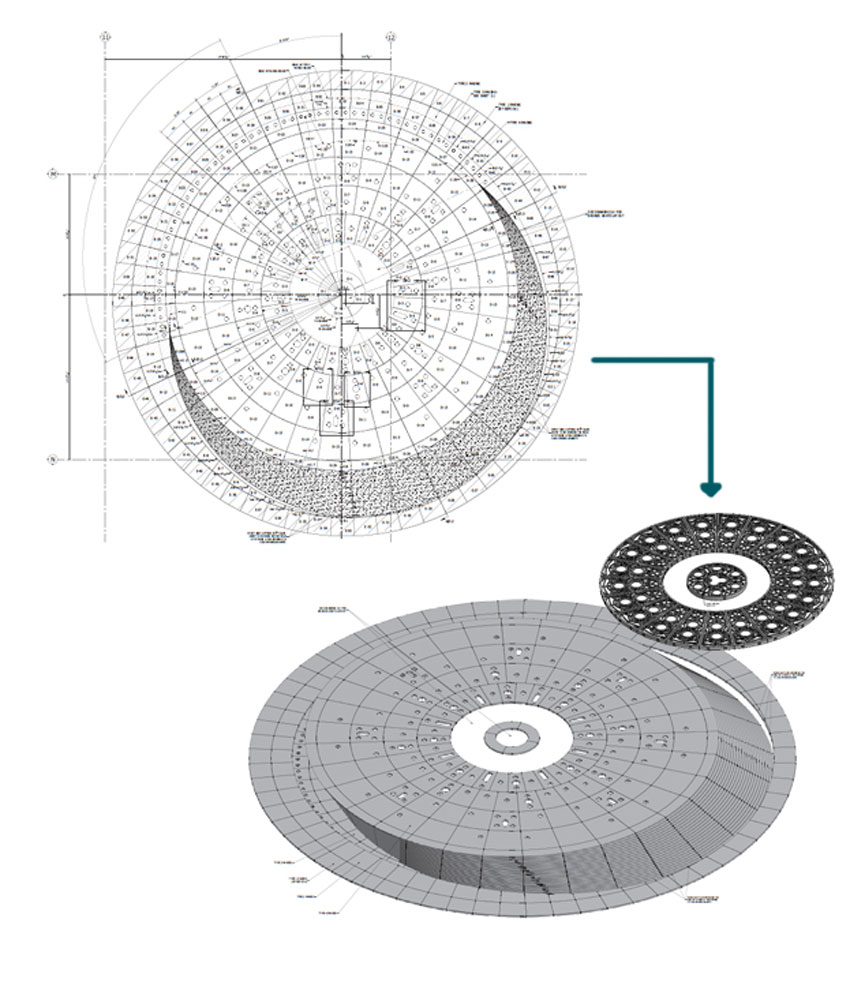Digital Fabrication and Natural Stone
Identical Granite + Multiple Finished = Unified Design
Diocese of Wheeling-Charleston Campus Plan, Wheeling, West Virginia
Finishes bring variety and versatility to a project and can unify the design palette. Some fabricators have developed a wide variety of finishes that increase a designer’s choices for applications throughout a project, both inside and outside.

Photo: © Amesse Photography
When constructing the new barrack at West Point, the design team chose to match the existing feel and color of the 200-year-old campus’s gothic revival architecture. It chose two types of black granite in order to provide the Army with new campus structures that will last another 200 years.
Different finishes accent different surfaces, and they can be used as clues for wayfinding. For example, a different finish can indicate the approach to a bench, stairs, or object. A different finish can be used to help create a slip-resistant surface applied as a universal design principle or create a highly reflective, smooth surface that magnifies the stone’s appearance.
The new Diocese of Wheeling Campus Plan in Wheeling, West Virginia, provides the first example of how a design team used the change of finish for both practical and dramatic effect.

Image courtesy of Coldspring
Approximately 6,000 square feet of black granite unified the design of the new Campus Diocese of Wheeling, West Virginia. Working closely with the fabricator and granite supplier, Michael Stern ASLA, LEED AP, notes, “By varying the finishes, we created different looks with the same stone.” Multiple finishes are available from the same natural stone that change the look of the stone while unifying the projects materials.
The architect and landscape planner chose black granite with a complex crystalline structure as the primary finish material. “We used the same black granite for many elements in this project—from fountains and pools to paving and steps,” says Michael Stern, ASLA, LEED AP, founding principal of Strada Architecture, Pittsburgh and Philadelphia.” This granite is known for its medium black and gray hues, which are more or less pronounced depending on the finish selected.
The existing rectory was built of sandstone that was echoed for key design elements on the chancery’s new wing. Designed by architect Edward Weber and completed in 1926, the historic Cathedral of Saint Joseph is a Neo-Romanesque style with windows laced with decorative stone elements. Limestone and many other natural stones are present at the site. “With the variety of natural stones at the site, the use of granite for all walkway areas creates a uniform contrast on the ground plane,” says Stern. “Granite was the unifying material at the site—tying together all the other materials.”
In 2011, the diocese initiated a major reorganization project for the campus of St. Joseph Cathedral, where the diocese had outgrown its existing 1950s-era chancery that houses the diocese’s administrative offices. The existing campus included numerous buildings serving the area’s Catholic community: St. Joseph Cathedral, the chancery, rectory, and archives, as well as a high school and elementary school. Plans for the reorganization included closing the existing elementary school due to low enrollment and renovating the building into a new chancery.
This reorganization also involved the construction of landscape elements that would connect the old and new areas of the site and create enduring public spaces. These included the development of a community central courtyard and a garden dedicated to the Virgin Mary, adding to the sense of place and worship. A new fountain in the courtyard adds elements of movement and sound, creating an inviting and serene gathering area.
Approximately 6,000 square feet of black granite unified the design of the new campus. Working closely with the fabricator and granite supplier, Stern notes, “By varying the finishes, we created different looks with the same stone.”
The lightest finish was selected for the pedestal of the St. Joseph statue in the plaza and the paving around the plaza tree bosque. (A bosque is a group of trees planted in a geometric grid. An element of spatial design that can be seen in ancient to contemporary gardens, the bosque symbolizes a forest and provides shade in public settings.)
A hone finish that highlights the stone’s crystal structure while deepening its background hues was selected for cubic benches in the Marian garden area, the fountain’s paving and coping, and the main fountain feature. It also provided the ideal finish for a pedestal for a statue of the Virgin Mary, which stands peacefully in the Mary Garden outside the archives building. This was a darker shade than the more textured finish used in the granite for pavers and stairs.

Photo: Prestige Photography
Precise fabrication using computer-aided design and CNC machines was essential for the fabrication of the fountain’s base and bowl. A hone finish that highlights the stone’s crystal structure while deepening its background hues was used for the fountain and paving in the courtyard.
For pavers and steps, a rough, slip-resistant surface was required for pedestrian areas. Natural stone materials vary with finishes, and the fabricator recommended a surface treatment that would provide the safest surface for exterior paving, stairs, and ramps. The rough-surface granite used throughout this campus sparkles in the sunshine while providing a safe walking surface for pedestrians in the courtyards and exterior passageways.
Precise fabrication using computer-aided design and computer numeric control (CNC) machines was essential for the fabrication of the fountain’s base and bowl. Tight seams and exact placement of each stone controls and directs water in this central water feature. “The manufacturer was able to take our design drawings and implement them with precision. The pieces they fabricated were really well executed. I think the diocese is very happy with the way the project turned out,” Stern says. “It’s resulted in a whole new public space for the campus. We were able to open up an area to be enjoyed by the Catholic community and the people of Wheeling.” The design complements the historic structures on the campus and adds value in the creative value of designing with contemporary stone fabrications and finishes

Image courtesy of Coldspring
According to the design team, choosing a manufacturer with high-performance digital fabrication allowed the design team to produce shapes that would have been nearly impossible years ago for this spectacular fountain in Salt Lake City.









